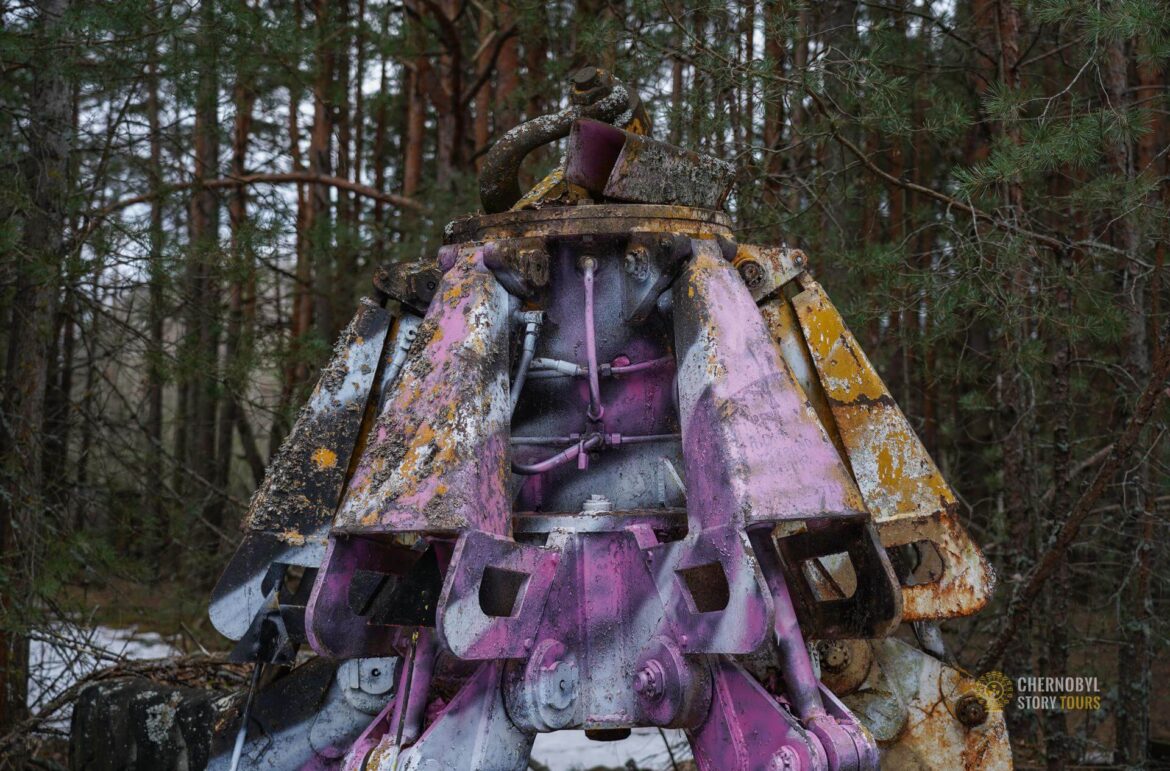The Claw of Death
The Chernobyl tragedy happened almost 40 years ago, but it has not been forgotten to this day. The huge exclusion zone around the nuclear power plant keeps many terrible exhibits on its territory, for example, the claw of death.

One of the Most Radioactive Sights of Chernobyl
The claw of death or a radioactive bucket – this particular exhibit is being sought as one of the most dangerous and radioactive in Pripyat.
The artifact, which both scares and attracts tourists, is hidden between the trees. The bucket took its place from the moment when the operation to clean up the yard of the Chernobyl plant was ended.
Today, it is located in the yard of the Service of Special Engineering Works in Pripyat. The claw was used in the decontamination process of the Chernobyl nuclear power plant in 1986. According to different data, it was involved in cleaning up the roof of the exploded unit either from concrete or uranium and graphite debris.
Why the bucket was left in the middle of the road is not clear. Probably in a hurry, the bucket was simply left in place and forgotten about. But thanks to this, it turned into an interesting exhibit, which is always included in the tours to Chernobyl.

What is the Radiation Level Near the Claw of Death
Even now, it is highly contaminated. You can measure there from a couple of dozens of microsieverts to more than thousands μSv/hour.
According to the dosimeter, the radiation level at a distance of 10 meters from the claw of death is already off the scale. And near it, gamma radiation is 130 micro roentgen per hour.
Notice that the natural background is considered to be no more than 20 mR / h. The average annual dose according to SanPiN for a person is 0.5 roentgen (together with 3-fold fluorography per year, and civil aviation flights).

Is It Dangerous to Visit the Claw of Death
Despite the increased level of radiation, it is not too dangerous to approach the bucket itself from a distance, and even on an official excursion to Chernobyl this place is included in the program. Of course, it’s not good to go for a walk every day to places with high radiation levels. But to catch a deadly dose, you’d have to settle down there for a long time.
So visiting it isn’t dangerous when taking into account general safety rules of the zone. For example, if you take the figure of 13 mR/h, then you would need to sit inside the bucket for about 38 hours to receive a dangerous dose of radiation. You should not do this, of course. Many visitors who come to Chernobyl are tempted to take photos near the Claw of Death or even inside it—but this is strictly forbidden. Approaching the bucket closely or attempting to touch it is prohibited due to safety concerns.
The strangest thing is that the bucket is still just lying on the surface not far from the accident place. It cannot be buried or melted due to the possible irradiation of the soil and groundwater. You can see The Claw of Death with your own eyes with our exclusive Chernobyl tours.
The Claw of Death in Chernobyl FAQ
What is the Claw of Death in Chernobyl?
The Claw of Death or Claw of Chernobyl is a heavy-duty piece of machinery that was used to remove highly radioactive debris immediately after the Chernobyl disaster. Its nickname comes from its appearance and the dangerous task it performed.
Where is the Claw of Death located?
The Claw of Death is currently located in the Chernobyl Exclusion Zone, where it remains highly radioactive. It can be seen during certain guided tours of the area.
Is the Claw of Death safe to visit?
As the Claw of Death is still highly radioactive, visitors cannot get too close to it. It is safe to view from a distance, as indicated by tour guides.
Can I take pictures of the Claw of Death?
Yes, it’s generally safe to take pictures of the Claw of Death, but remember to maintain a safe distance and follow the instructions of your guide.
What role did the Claw of Death play in the Chernobyl cleanup?
The Claw of Death was used to handle and remove highly radioactive materials from the site of the disaster. This included debris from the exploded reactor.
Is the Claw of Death the only piece of its kind?
There were several similar pieces of machinery used in the cleanup effort, but the Claw of Death is one of the most well-known due to its continued high levels of radioactivity.
- - Hostomel
- - Irpin
- - Bucha
- - Romanivka
- - Borodyanka
















Total comments: 1
Interesting the Claw Of Death it’s just fascinating and weird how it was used and left to rust.